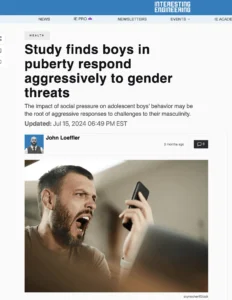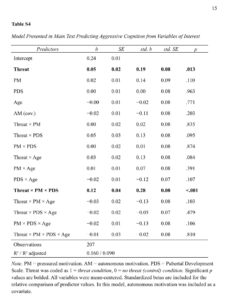By: Tom Golden
There’s a noticeable pattern in analysis about women and men that always tells solely a part of the story. A primary instance is home violence research that falsely declare girls are the only victims, whereas ignoring males’s experiences. This occurs in different areas too—like reproductive coercion, teen violence, healthcare, and others. Ladies’s troubles are spotlighted, whereas males’s are neglected. When you see this sample, it’s laborious to unsee it.
On this put up, we’ll take a look at a research revealed in July of 2024, that employs an identical technique—not by mendacity, however by omission. The researchers current solely the a part of the story that helps the narrative they need to push.
And on this case, it’s clear.
I got here throughout a media article about boys and threats to their masculinity. From the image beneath that accompanies the article, I anticipated some dramatic findings on violence or hostility.
The analysis claimed to research adolescent boys’ responses to threats to their masculinity.

Right here’s a fast abstract of the research:
The research was easy.
207 boys, ages 10-14, got two quizzes—one on stereotypically female subjects like flowers, make-up, and clothes, and one on masculine subjects like instruments, weapons, and automobiles. No matter their precise scores, the management group was advised they’d scored excessive on the masculine take a look at and had been congratulated. The boys within the experimental group, nonetheless, had been advised they scored nicely on the female quiz however poorly on the masculine one. In different phrases, they had been advised they had been extra like the women—meant as a menace to their masculinity. The boys then took a 3rd quiz, a phrase completion take a look at designed to measure their stage of aggression. The mother and father took a sequence of questionnaires to evaluate their parenting.
The researchers aimed to see if this perceived menace would spark aggression. (One may additionally ask if the boy’s aggression may be sparked just because they had been lied to. In any case, they most likely had been nicely conscious that they knew extra about weapons and automobiles than make-up and clothes.)
One of these response has been studied earlier than and has been recognized as “menace vigilance,” a standard response to standing threats amongst males and boys, typically linked to testosterone ranges. Research present that when a male’s standing is challenged, he’s extra probably than a feminine to reply aggressively, partly resulting from larger testosterone. Nonetheless, prepubescent boys sometimes don’t show this aggression, as they haven’t but reached the upper testosterone stage of life. Curiously, regardless of inspecting what seems to be this similar phenomenon, the research in query makes no point out of the earlier analysis about menace vigilance. As we are going to later uncover, the researcher was conscious of this idea however selected to not embrace it within the research.
The media article I first learn didn’t point out menace vigilance and even point out testosterone, although it’s a key think about one of these analysis. Pondering I may need missed one thing, I looked for different articles on the research and located many—however nonetheless, no point out of testosterone in any of the articles.
What I did discover had been media portrayals displaying indignant, hostile boys, although the researchers themselves didn’t declare the boys had been violent.
Right here’s a quote that appeared in most of the articles: “Past simply aggression, manhood threats are related to all kinds of unfavourable, delinquent behaviors, corresponding to sexism, homophobia, political bigotry, and even anti-environmentalism,” stated the researcher, Adam Stanaland. Wait, what? How did we leap from threats to standing to sexism, homophobia, political bigotry, and even anti-environmentalism? This felt like an enormous leap, although it’s value noting the researchers didn’t immediately say boys had been violent. It appears the media exaggerated that half as seen within the photographs, and I doubt the researchers did a lot to right it.
Considerably confused about this, I made a decision to search out the precise research and browse it. Testosterone was talked about—as soon as—within the limitations part, suggesting that future research might discover its function. This made no sense, provided that present analysis clearly hyperlinks testosterone to menace vigilance and standing protection. This puzzled me and I used to be decided to search out out what was happening so I wrote to the researcher with some questions.
He acquired proper again to me and we carried on a dialog. He was a really good fellow and I do admire his initially taking the time to subject my questions. The sense I acquired was that he was concerned with pushing the “it’s all about socialization” concepts. I regarded up his historical past and his graduate work was accomplished at Duke College and he was a member of the Duke “Id and Range Lab” for five years. The identify says all of it. I believe my assumptions had been fairly shut. He was more likely to observe the concepts that socialization is essentially the most crucial factor of human growth.

Once I requested him, “Isn’t menace vigilance associated to testosterone ranges?” he responded: “Basal testosterone and aggression are actually associated, however right here our focus was determining whether or not a social mechanism (i.e., typicality/masculinity menace) might additionally trigger aggression amongst adolescent boys (because it does amongst males), in addition to when/why.”
In different phrases, he didn’t reply the query. He acknowledged the organic hyperlink however selected to focus solely on the social side. To me, that is like learning a automobile engine however solely wanting on the spark plug and ignoring gas, air, and combustion. A well-rounded research would acknowledge that each testosterone (organic) and socialization play necessary roles. Omitting one facet seems like an intentional strategy to push a story.
I requested the researcher once more if he was conscious of research displaying testosterone’s function in menace vigilance, and he responded: “Sure, I’m conversant in the advanced function between testosterone, menace vigilance, status-seeking, and aggression. My earlier rationalization was all to say that there’s positively a organic element to aggression, however our outcomes present proof that there’s additionally a notable social element.”
Mainly, he’s saying, “Sure, testosterone issues, however we’re specializing in the social facet.” And that’s how narratives are constructed, by telling solely part of the story. Sadly, this research—like many others—implies that boys may very well be “fastened” if solely they had been taught to be much less aggressive when their masculinity is threatened. However this ignores the organic issue. As soon as boys hit puberty, larger testosterone ranges biologically predispose them to defend their standing. But, this important piece of data is disregarded of the dialog.
Puberty
The research targeted on 10-14 yr previous males from pre-puberty via mid- and late-puberty phases. The researchers made a number of statements that highlighted their views on puberty, together with this one:
“We contend that puberty represents a developmental shift in boys’ psychological relationship with societal definitions of their gender.”
The researchers acknowledged that puberty is a vital think about these behaviors, however what does puberty primarily sign? It highlights the rise in testosterone ranges in younger males. Nonetheless, the researchers by no means point out testosterone. As a substitute, they describe puberty like this:
“We contend that puberty represents a developmental shift in boys’ psychological relationship with societal definitions of their gender. Puberty causes boys to acknowledge themselves—their our bodies, their relationships, and so forth—as being adult-like, which suggests they need to now take care of newly found societal expectations of manhood: a precarious standing that’s earned, might be misplaced, and is barely regained by conforming to inflexible norms, corresponding to aggression.”
Their interpretation means that boys, upon recognizing their maturing our bodies, should now face “societal prescriptions about manhood.” The main target right here is totally on socialization, asserting that boys should conform to inflexible societal norms. There’s no point out of testosterone—it’s all framed round societal pressures, leaving organic components out of the dialogue totally.
The Phrase Completion Check
One other challenge I had with this research was their methodology of measuring aggression: a phrase completion take a look at. The boys had been requested to fill in blanks like “GU_” (which may very well be “gum” or “gun”) and “_UNCH” (which may very well be “punch” or “lunch”). The variety of aggressive phrases chosen supposedly indicated their stage of aggression. I discover it laborious to consider this take a look at precisely measures aggression, however the researcher assured me it had been validated in different research. It appears to me that they’re taking a cognitive response after which anticipating that cognition to foretell an precise conduct. Appears wonky to me. I used to be pretty new to the phrase completion checks and poked round a bit and located that there’s appreciable controversy about this. As there must be.
I proceed to assume it is a very weak indicator however the research acquired magazines to print pics like this primarily based on selecting gun somewhat than gum:

These photos, like the opposite photos on this put up, suggest not solely aggressiveness however hostility. Looks as if a leap to me. There’s a huge distinction between aggressively defending your standing, which is what menace vigilance does, and overt hostility or violence. Appears to be like like they’re making an attempt to suggest the later. However that is what the media desires. Give them some analysis that reveals the boys and boys are aggressive and they’ll put violence on the entrance web page. No matter occurred to the phrase assertive which is analogous to aggressive? I believe assertive may be a greater phrase for males defending their standing. Their protection in some instances would possibly get aggressive however the norm may be merely responding to the problem in a robust, rational, and assertive method.
The Pattern
The pattern used within the research additionally raised some questions. Practically 90% of the mother and father concerned had been moms, and greater than two-thirds had been single mother and father. That is far above the nationwide common for single-parent households, which hovers round 20-25%. Analysis reveals that boys raised by single moms usually tend to exhibit aggression, but the research doesn’t deal with how this may occasionally have influenced the findings.
“Concerning the mother and father themselves, 87.4% recognized as girls (moms) and 12.6% had been males (fathers). Most mother and father had been the only major caretaker of the participant (68.6%) or shared caretaking tasks equally with one other individual (30.0%).”
I requested the researcher concerning the probabilities of a biased pattern because of the massive variety of single moms and here’s what he stated:
“I’m undecided that it’s truthful to say that our pattern comprising a majority of moms is “sturdy indication that [we] had a biased pattern.”
Analysis has proven that though dads are extra concerned now of their little one’s caregiving than they was once, mothers are nonetheless vastly overrepresented (hyperlink) because the little one’s major caretaker. It is smart, then, that our pattern would comprise extra moms than fathers—i.e., it’s consultant and never biased (the truth is, a pattern with half moms and half fathers could be biased in opposition to the truth of parenting within the U.S.).”
Possibly so, however he doesn’t deal with the over-abundance of single moms within the pattern and the way that’s removed from the norm for parenthood within the US immediately. I particularly identified the one moms challenge and he merely prevented it and targeted on moms doing the vast majority of little one care. The hyperlink he supplied was not about single moms, it gave the impression to be about two dad or mum households. If he had 87% moms in his pattern and so they had been all from two dad or mum households, then that might be a special story. However that was not the case. It was 87% moms and a pair of/3rds single mother and father. This tells us that it’s probably most of these moms had been single mother and father. A predominance of single moms must be a pink flag, however not in his view. May the surplus of single moms have had an impression on the findings?
I do surprise.
Framing Dad and mom because the Downside
One key takeaway from the research was that boys from conservative, much less rich households with mother and father instructing “hegemonic masculinity” had been extra aggressive in response to the menace. The device used to evaluate this was the Male Function Norms Stock, which incorporates statements like these:
-
Males ought to know how one can repair automobiles.
-
Males must be bodily powerful.
-
It might be terrible if a person loved dressing like a girl.
-
A person ought to be capable to repair most issues round the home.
-
A person ought to at all times be the boss.
-
Males ought to lead their family.
-
A person ought to at all times be prepared for intercourse.
If the mother and father rating excessive on this questionnaire they’re assumed to be instructing their boys to be “hegemonic”. Hegemonic is seen as one thing unhealthy.
It’s meant to say that males are controlling and dominant.
It comes from the writing of R. Connell who a while in the past grew to become a transwoman. Many teachers appear to search out Conell’s guide because the important phrase in Masculinities. The elements I’ve learn appear extremely anti-male. Connell’s guide introduced an excessive amount of turn into the analysis on males the place lots of his concepts had been unceremoniously and artificially planted into research like within the Conformity to Masculine Norms Stock (CMNI). I did a report on the CMNI and the very suspect method that it was developed with a deal with how Connell’s concepts magically appeared. You may see that one right here.
The researchers appeared to deal with the parental stress (hegemonic attitudes) as being a main motivator for the boy’s aggressive responses. They titled that variable pressured motivation (PM). When studying the media articles it appeared that this parental stress was being portrayed as being a big a part of the explanations for the aggressive responses. This may lend credence to the concept boys may very well be fastened if mother and father would simply cease instructing them to be hegemonic males. However wait a minute. The PM variable (parental stress) when paired with the menace variable (the phrase completion take a look at) solely had a significance rating of p=.835. Normally a rating of .05 or beneath is taken into account to be important so this one was far off the mark. However in addition they had a variable that indicated the Diploma of Puberty for the Boys (PDS) which confirmed that the one boys to look aggressive in response to the phrase completion had been boys who had been in mid to late puberty. When that PDS variable was paired with the menace variable (the phrase completion take a look at) it got here up with a rating of p=.095. Nonetheless not thought-about important however absolutely extra important than the parental stress variable. When each the PM and the PDS had been paired with the menace variable, voila! They get a significance of <.001.
Merely put, the information recommend that puberty (and its related modifications) has a stronger affect on the boys’ aggression than social stress alone. This reinforces the concept organic components, like testosterone, could also be necessary drivers for these aggressive responses, even when the research didn’t say so immediately.
If puberty is so intently linked to aggression, and testosterone is likely one of the major hormones behind puberty, doesn’t it stand to motive that testosterone may be a key issue? The truth that the puberty variable reveals a stronger impact than pressured motivation solely strengthens the argument that the organic facet of adolescence is crucial right here.

One does are inclined to surprise if defending one’s standing as a male is such a nasty factor as it’s being portrayed on this analysis. There are some good causes for it. Males are strengthened and rewarded for independence and for his or her skill to guard. Being seen as impartial and in a position to defend is part of the male hierarchy. However in a extremely gynocentric environment these as soon as extremely valued traits are framed in a unfavourable method. If you consider it, perhaps the boys who didn’t defend their standing are literally those who need assistance?
Conclusion
In the long run, I by no means acquired solutions to all my questions.
It’s been a month and a half for the reason that researcher stopped responding, however I’m left pondering this research was designed to push a specific narrative, one which minimizes organic components and highlights social ones.
This leaves individuals pushed in the direction of the narrative that boys might be fastened (and be extra just like the women) if solely the mother and father and the tradition would cease instructing them to be aggressive.
It’s true that analysis typically focuses on a selected, slender side of psychology. I’ve learn many research that observe this sample. Nonetheless, in these research, there was at all times a bit that reviewed earlier analysis on the subject and acknowledged earlier work within the subject. This research, sadly, didn’t do this in any respect.
However there’s one thing necessary that may be gleaned from this research that even the researchers missed: pre-puberty boys didn’t reply aggressively to threats to their masculinity.
This strongly means that puberty—and by extension, testosterone—is vital to understanding these behaviors.
But testosterone was by no means mentioned in any significant manner.
Simply as an engine wants each a spark and gas to run, adolescent boys’ aggressive responses to threats to their masculinity probably contain each social triggers and organic components like testosterone. By together with each within the evaluation, we will transfer past a one-dimensional rationalization and begin to perceive the advanced interaction of things that drive conduct throughout this crucial interval of growth.
In the long run, it’s not nearly what makes the engine run — it’s about understanding all of the elements that come collectively to make it work easily. And in terms of adolescence, testosterone is an enormous a part of that equation.
Males Are Good
MenAreGood.com & MenAreGood on Locals MenAreGood on Substack
Tom Golden, as seen within the Pink Tablet Film, is a psychotherapist who has written three books on boys and males and the distinctive methods they heal from loss and trauma. He has given workshops in the USA, Canada, Europe and Australia.
https://substack.com/@menaregood?utm_source=about-page

